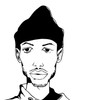Installation view: Disguise: Masks and Global African Art. Photo: Jonathan Dorado.
Saya Woolfalk (American, born 1979). Installation view of ChimaTEK: Virtual Chimeric Space (detail), at Seattle Art Museum, 2015. © Seattle Art Museum. Photo: Nathaniel Willson
Brendan Fernandes (Canadian, born Kenya, 1979). From Hiz Hands: 1979.206.143, 2010. One of three neon-on-glass-frame signs, 35 x 30 in. (88.9 x 76.2 cm). Loan from the artist. © Brenden Fernandes. Photo: Courtesy of the artist
Zina Saro-Wiwa (British/Nigerian, born 1976). The Invisible Man, 2015. Pigmented inkjet print, 28 ¾ x 44 in. (73 x 111.8 cm). Seattle Art Museum, Commission, 2015. Courtesy of the artist. © Zina Saro-Wiwa
Unidentified Gola artist. Helmet Mask (Gbetu) with Raffia Costume
